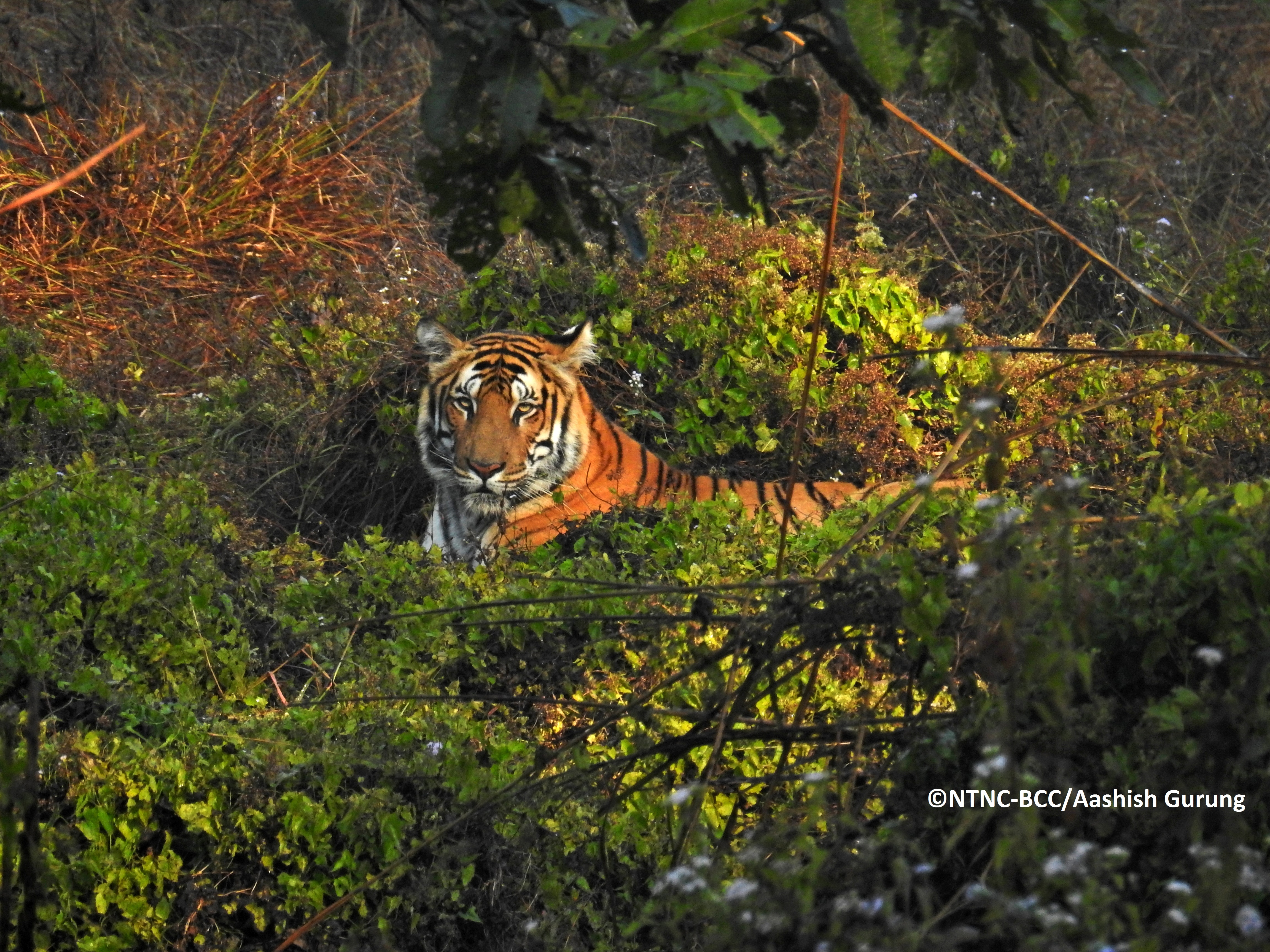During National Conservation Day of 2018, Nepal proudly announced the existence of 235 wild tigers. The number is nearly the double of 121 tigers that existed in the year 2009. In a mere time of 9 years, there has been a tremendous increase in the number of tigers which provides an optimistic view of the rich biodiversity in our country. With this tremendous increase that has happened recently, Nepal has shown the full potential of becoming the first country to double the number of its tigers in alignment with its ambitious goal of doubling the number of tigers in the world which was set at St. Petersburg Tiger Summit at 2010.
The conservation success story of Nepal was well recognized in the international platform as magazines like ‘Wanderlust’ and ‘National Geographic’ appreciated Nepal’s efforts to double the number of tigers in the country. This tremendous increase in the number of tigers was due to the contribution of various factors. To know what all helped Nepal increase the number of tigers and what steps are being taken to continue such protection forward, we communicated with 4 people who have closely worked towards tiger conservation. Below provided are their insights about tiger conservation in Nepal.
- Human Wildlife Conflict Transforming to Become Human Wildlife Companionship:
The major credit for the protection of tigers has to be given to the community itself. It was because the community supported tiger conservation that it was possible to increase the number of tigers. On the contrary, if the community violates tiger conservation measures, it is still possible for this number of tigers to go down drastically.
The human wildlife companionship led to Nepal celebrating the achievement of 365 days of zero poaching of rhinos on five occasions between 2011 and 2018. Nepal declared and celebrated this achievement in the month of May. (WWF Nepal, 2018)
The government has a policy where 30 to 50 percent of the income that is generated from tourism in the protected areas goes back to the community itself. This has been a major motivating factor to bring on community support. The community does understand that the protection of forest areas and the animals inside of it is ultimately going to lead to better tourism which is going to mean more economic and social development for them because of which their support towards protection efforts increases.
These are all the positive prospects of tiger conservation. However, there have been cases where humans have been attacked and brought to death by animals too. According to a research, 54 human casualties including 32 fatalities and 22 injuries and 351 incidents of livestock harm were recorded between the year 2007 and 2014. (Rajendra Dhungana, 2017)
The government is taking both preventive and curative measures to minimize the human tiger conflict as much as possible.
According to Mr. Sindhu Dhungana, Joint Secretary and Chief of Planning, Monitoring and Co-ordination Division of Ministry of Forests and Environment, “When we have to specifically talk about tigers, the cases of human tiger conflict are little less severe as tigers tend to be shy animals and don’t prefer to come outside of their habitat. However, there have been cases of other human wildlife conflicts and this is becoming a serious problem.”

Ministry of Forestry and Environment
He further added saying “The government has also recently revised the relief package for the harm caused due to human wildlife conflict. In case of death, the government now provides NRs.10, 00,000 as a compensation. In case of injuries and casualties that cost more than NRs. 2, 00,000, the government provides free health services to the injured people in government hospitals.”
Sharing the long term vision about reduction in human tiger conflict, Mr. Dhungana stated, “We have also started raising awareness in the community people about raising the crops that are not preferred by animals and to change their agriculture patterns. This can lead to greater safety environments. However, the implementation of this measure completely depends on the people themselves as we cannot force them to do or not do something.”
- Co-ordinated efforts between Nepal and India for tiger conservation:
Nepal and India have joined hands together for tiger conservation and because we share joint landscape, the efficient and fluent co-ordination between both the countries has played an important role in increment in the number of tigers.
There is a separate Terai Arc Landscape which is recognized by both the governments and this program was initiated in 2001. This vast landscape covers an area of 49,500 square km which extends from Nepal’s Bagmati River in the east to India’s Yamuna River in the west. It encompasses 14 protected areas, and in Nepal, the area covered by TAL is 23,199 square km across 14 Terai districts.
According to Mr. Kanchan Thapa, Wildlife Lead at WWF Nepal, “The memorandum of understanding between Nepal and India for protection of biodiversity has been successful an indicator of which has been increase in number of tigers. Our vision is to ensure that animals know no boundaries. The long term vision of this Terai Arc Landscape was to ensure free movement of animals between the countries so that tigers can explore their habitat freely.”

He also stated, “The countries have been working jointly in information sharing and in maintaining security so that tigers can be saved. We are currently undergoing a project to double the number of tigers in the area of Parsa National Park, Chitwan National Park and Valmiki Tiger Reserve through a strategic trans-boundary project which is jointly implemented by WWF Nepal and India with support from respective governments.”
Hence, the strategic relations that the countries have been sharing with each other for the protection of tigers proves a very important point that ‘Boundaries and borders can only separate humans. Animals are free from such bindings and they only spread love and unite themselves and others.’
- Protection of tigers requires protection of their habitat and prey species:
Tigers are the topmost carnivores. For protection of tigers and increase in their numbers, there are three major requirements that have to be fulfilled – Protection of their natural habitat, protection of their prey species and strict protection against poaching and illegal trade of their body parts.
As said by Mr. Naresh Subedi, Conservation Program Manager at NTNC Nepal, in order to sustain 100 tigers we need an average of 15,000 to 20,000 deer sized spotted animals.

As the number of tigers are increasing in the limited protected areas, now a fear is arising that tigers will involve in scuffles and competition amongst each other and other carnivores like leopards for food which might limit their rising numbers.
In the month of March 2018, 4 rare Bengal tigers had died in the South Central Nepal, the cause of which is being associated to scuffle between the rival animals for preys. (Daily Sabah, Environment, 2018)
According to Mr. Subedi, “There are three major requirements for tiger conservation – abundant prey species, ample habitat and no poaching. Currently, in the protected areas, we are in a constant effort to ensure that there is availability of ample amount of prey species. Likewise, the forest areas in the protected areas are also lush green which helps animals live freely.”
Explaining about conservation mechanisms, he further clarified, “The National Parks and Wildlife Reserves are guarded by Nepal Army while regular management of habitat and park administration is done by Department of National Parks and Wildlife Conservation. The buffer zones around the park and forest areas outside the parks are guarded by local communities, Department of Forest and Nepal Police. Wildlife crime control bureau has been set up from central level to district level. The bureau has representation from all security agencies and wildlife enforcement agencies. Thus, a coordinated and consolidated effort to halt wildlife crime in Nepal has been successful at the moment.”
The tiger conservation that has taken place required proper synchronization and co-ordination between various agencies and in future too this co-ordination should carry on if we want to see a surge in the number of tigers.
Bardiya National Park has seen a sharp rise in the number of tigers as the number of tigers rose from 18 to 87 in a mere time of 9 years between 2009 and 2018. (As per the data by NTNC). Even if areas like Chitwan have become overpopulated with sudden increase in number of tigers, the numbers can now be accommodated in Bardiya National Park, Parsa National Park and Banke National Park.
The wetlands, the forest areas and the habitat of all the animals need to be protected because in case of animals, they largely depend upon each other for food and for a well-balanced ecosystem in the animal kingdom, a balanced protection mechanism should be introduced.
- Tourism can flourish through tiger conservation:
When we talked to Mr. Sunil Sharma, Senior Manager of Research Planning and Monitoring Development at Nepal Tourism Board, he was joyful and he shared how Wanderlust, which is an international travel magazine had shared about Nepal due to its successful efforts in tiger conservation.

Nepal Tourism Board
As stated by Mr. Sharma, “The tiger conservation that took place helped Nepal gain a positive publicity in the international platform. It sent out a positive message that irrespective of what the size of Nepalese economy might be, the country is rich in biodiversity.”
Mr. Sharma also further clarified that, “This can help us build special tour packages. For people who want to see the beauty of Himalayas, they can do so, for people who want to enjoy wildlife tourism, they are free to do so. We are organizing VISIT NEPAL 2020 with the theme of providing lifetime experiences to people and being able to watch the animals freely moving in their habitat is one of the most pleasurable experiences for many. These are the kind of beautiful experiences that our country can provide and this definitely helps boost tourism in the country.”
Steps should now be taken to ensure that tourism and wildlife protection go hand-in-hand. The private sector should always have in the back of their head the long term vision. The inflow of tourists is ultimately going to become less if the biodiversity is not protected and hence biodiversity conservation and tourism activities that the private sector conduct should go hand-in-hand.
The efforts that Nepal has been taking towards tiger conservation and the results it is translating has been commendable and Nepal deserves a pat in the back for that. However, this is one milestone that Nepal has achieved and to achieve better milestones and to move ahead further in the path of tiger conservation, Nepal needs to ensure that such efforts keep on going. Tigers know no boundaries and tiger conservation in Nepal means tiger conservation in the world.
Mr. Subedi from National Trust for Nature Conservation rightly said, “We need to take on a few lessons from the past that we had dedicated towards wildlife conservation. The first lesson being that continuous communication within and outside the box is a must when it comes to things like nature conservation. It is through constant communication that the integrated efforts for tiger conservation have been possible in Nepal which begins from the government level and passes down to the local level. Similarly, nothing is possible without community support. The royalty sharing system that Nepal has brought up, has become a major motivating factor for the community as a result of which the community has always been supportive towards wildlife conservation because of which we are here.”
Though Nepal might be a small economy, it is a diverse one and with the unification of the various stakeholders in Nepal, Nepal has not only give an example of ‘Unity in Diversity’ but also shown how team work can lead to results that are fruitful. The tiger conservation that Nepal has done is tremendous and through it, Nepal has set its example in the world!
Article Written by: Mahima Poddar







